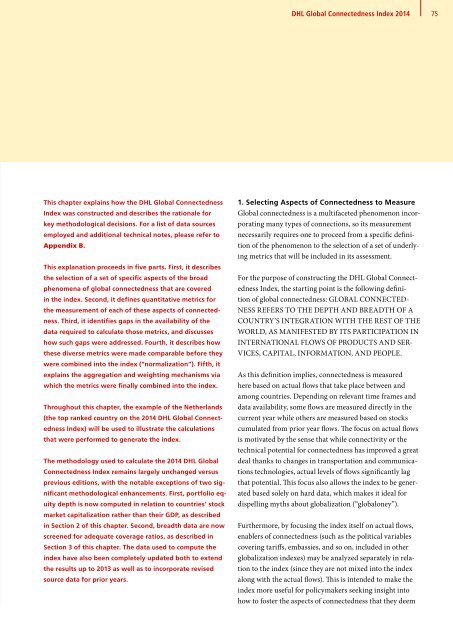DHL Global Connectedness Index 2014
DHL Global Connectedness Index 2014
DHL Global Connectedness Index 2014
- No tags were found...
Create successful ePaper yourself
Turn your PDF publications into a flip-book with our unique Google optimized e-Paper software.
<strong>DHL</strong> <strong>Global</strong> <strong>Connectedness</strong> <strong>Index</strong> <strong>2014</strong><br />
75<br />
This chapter explains how the <strong>DHL</strong> <strong>Global</strong> <strong>Connectedness</strong><br />
<strong>Index</strong> was constructed and describes the rationale for<br />
key methodological decisions. For a list of data sources<br />
employed and additional technical notes, please refer to<br />
Appendix B.<br />
This explanation proceeds in five parts. First, it describes<br />
the selection of a set of specific aspects of the broad<br />
phenomena of global connectedness that are covered<br />
in the index. Second, it defines quantitative metrics for<br />
the measurement of each of these aspects of connectedness.<br />
Third, it identifies gaps in the availability of the<br />
data required to calculate those metrics, and discusses<br />
how such gaps were addressed. Fourth, it describes how<br />
these diverse metrics were made comparable before they<br />
were combined into the index (“normalization”). Fifth, it<br />
explains the aggregation and weighting mechanisms via<br />
which the metrics were finally combined into the index.<br />
Throughout this chapter, the example of the Netherlands<br />
(the top ranked country on the <strong>2014</strong> <strong>DHL</strong> <strong>Global</strong> <strong>Connectedness</strong><br />
<strong>Index</strong>) will be used to illustrate the calculations<br />
that were performed to generate the index.<br />
The methodology used to calculate the <strong>2014</strong> <strong>DHL</strong> <strong>Global</strong><br />
<strong>Connectedness</strong> <strong>Index</strong> remains largely unchanged versus<br />
previous editions, with the notable exceptions of two significant<br />
methodological enhancements. First, portfolio equity<br />
depth is now computed in relation to countries’ stock<br />
market capitalization rather than their GDP, as described<br />
in Section 2 of this chapter. Second, breadth data are now<br />
screened for adequate coverage ratios, as described in<br />
Section 3 of this chapter. The data used to compute the<br />
index have also been completely updated both to extend<br />
the results up to 2013 as well as to incorporate revised<br />
source data for prior years.<br />
1. Selecting Aspects of <strong>Connectedness</strong> to Measure<br />
<strong>Global</strong> connectedness is a multifaceted phenomenon incorporating<br />
many types of connections, so its measurement<br />
necessarily requires one to proceed from a specific definition<br />
of the phenomenon to the selection of a set of underlying<br />
metrics that will be included in its assessment.<br />
For the purpose of constructing the <strong>DHL</strong> <strong>Global</strong> <strong>Connectedness</strong><br />
<strong>Index</strong>, the starting point is the following definition<br />
of global connectedness: GLOBAL CONNECTED-<br />
NESS REFERS TO THE DEPTH AND BREADTH OF A<br />
COUNTRY’S INTEGRATION WITH THE REST OF THE<br />
WORLD, AS MANIFESTED BY ITS PARTICIPATION IN<br />
INTERNATIONAL FLOWS OF PRODUCTS AND SER-<br />
VICES, CAPITAL, INFORMATION, AND PEOPLE.<br />
As this definition implies, connectedness is measured<br />
here based on actual flows that take place between and<br />
among countries. Depending on relevant time frames and<br />
data availability, some flows are measured directly in the<br />
current year while others are measured based on stocks<br />
cumulated from prior year flows. The focus on actual flows<br />
is motivated by the sense that while connectivity or the<br />
technical potential for connectedness has improved a great<br />
deal thanks to changes in transportation and communications<br />
technologies, actual levels of flows significantly lag<br />
that potential. This focus also allows the index to be generated<br />
based solely on hard data, which makes it ideal for<br />
dispelling myths about globalization (“globaloney”).<br />
Furthermore, by focusing the index itself on actual flows,<br />
enablers of connectedness (such as the political variables<br />
covering tariffs, embassies, and so on, included in other<br />
globalization indexes) may be analyzed separately in relation<br />
to the index (since they are not mixed into the index<br />
along with the actual flows). This is intended to make the<br />
index more useful for policymakers seeking insight into<br />
how to foster the aspects of connectedness that they deem





